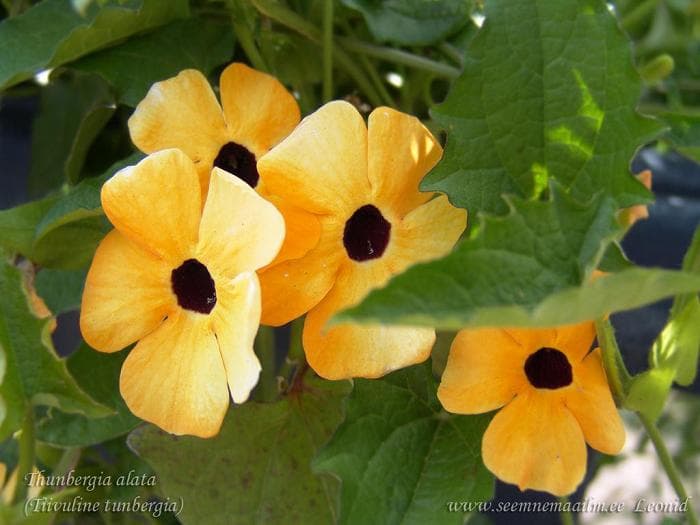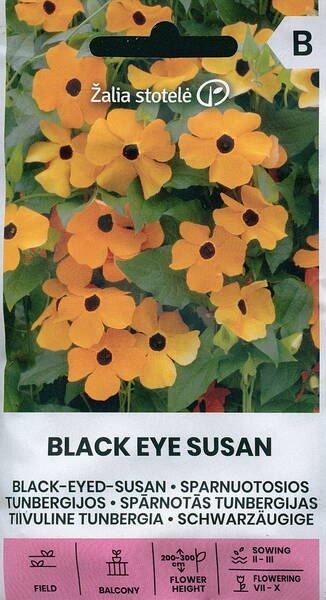A vine for rooms and balconies!
A herbaceous climbing plant reaching up to 2.5 m in height with large, spectacular flowers in rich yellow-orange hues, adorned with a black eye, which stand out clearly against the background of dark green, arrow-shaped leaves. Thunbergia is widely used for decorating supports and pillars, as well as for adorning balconies, terraces, winter gardens, and as a houseplant.

Sowing: Seeds are sown for seedlings in February-March on the surface of a moistened and compacted substrate, lightly covering the seeds with soil.
The crops are sprayed with a sprayer and covered with glass. Seedlings appear at a temperature of +18+20°C after 15-21 days. Seedlings are pricked out at the stage of 2 true leaves. Seedlings are planted in the ground when the threat of frost has passed.
Prefers sunny, warm places, if possible, not windy.
Care for the plant involves regular watering and feeding.
Flowers in August-September (thereafter, plants from outdoors can be moved indoors).
1.0 g = 35-40 seeds.

Sowing for seedlings.
Thunbergia can be grown from late February - early March, until the end of April. But the earlier you plant the seeds, the earlier flowering will occur. You can use any loose, nutritious soil, but a mixture of peat, sand, and garden soil in equal parts is considered best. In a common container, it's better to plant seeds 5-7 cm apart. Or simply plant them in seedling tray cells to avoid the hassle of pricking out. Seeding depth is 0.5-1 cm (you can just press them into the soil and lightly sprinkle on top). Afterward, moisten the crops with a spray bottle. To speed up germination, the crops can be covered with film, a bag, or glass, but this is not mandatory. Place the container in a warm place, monitor the moisture. As soon as seedlings appear (usually after 7 days), the cover must be removed.
Seedling care.
Caring for Thunbergia seedlings is not difficult. If sown in a common container, carefully transplant the seedlings into individual containers at the stage of 2-3 leaves. Use a fork for this, lifting the roots with a clump of soil. This way the plants will establish much faster and won't get sick. If sown in individual cells, transfer the grown seedlings to more spacious cups.
Water Thunbergia regularly, but without waterlogging. Above the 5th-6th leaf, pinch the top to direct the plant's growth into side shoots and get a densely leafy bush. You can feed the seedlings one or two times before planting out: one week after pricking out, then after 10 days.
Use complex fertilizers for flowering plants to provide the seedlings not only with nitrogen but also with phosphorus and potassium, which will allow for more flower buds to form. When and how to plant Thunbergia seedlings in open ground In the second half of May, when the threat of spring frosts has passed, Thunbergia can be safely planted in open ground or in garden planters. A week before planting, conduct mandatory hardening to prepare the plants so they don't get sick. For this, take them outside, gradually increasing the time spent in the fresh air up to a full day. Choose a location for planting Thunbergia in partial shade, where there is no strong wind or drafts.
A neutral environment and loose, nutritious soil are preferred. Heavy clay soils are best lightened by adding sand and humus. If the soil is acidic, add wood ash to it (this is the safest and most beneficial way to reduce its acidity). Lime is used for deacidification in autumn; doing this in spring is strictly forbidden.
It's better to prepare the planting holes in advance, according to the size of the root ball. Distance between holes is 25-30 cm. Before planting, be sure to prepare the support that they will climb. This can be a net, or special vertical supports tied with wire.
Sowing Thunbergia seeds directly in the ground.
For those who don't have time to fuss with seedlings, the fact that Thunbergia can be sown directly with seeds in the ground as soon as the soil is ready will be appealing. Seedlings will appear in just a week, and the fast-growing vine will bloom by mid to late June. When sowing in the ground, maintain a distance of 10-15 cm between seeds, then thin out to a distance of 20-30 cm between seedlings. At the stage of 5-6 leaves, don't forget to pinch to encourage the development of side shoots.
Care for Thunbergia in the garden.
Caring for Thunbergia in open ground is not difficult: simply water regularly so the soil doesn't dry out. Do not overwater, and especially avoid waterlogging.
Feeding is not mandatory: even without it, the vine grows very quickly and flowers well. But if Thunbergia is fed 1-2 times a month with complex fertilizers for flowering plants, growth and flowering will be even more intense.
How to collect seeds.
After flowering, Thunbergia forms seed pods. They need to be collected when the seed pod has dried but hasn't yet split open. Store the seeds in paper envelopes or cloth bags for many years. The main thing is that the storage temperature is not much higher than room temperature, otherwise there is a risk that the seeds will dry out and die.
Overwintering Thunbergia.
In open ground, the vine will die, so plants that grew in the garden need to be dug up (if you wish to keep them until spring) and transplanted into pots, and pruned for easy moving. And those plants that were in planters are simply moved indoors (pruned if necessary). In autumn, keep plants at +16+18°C, in winter lower the temperature to +13+16°C. Water moderately, not allowing the root ball to dry out completely. In spring, move the plants to the garden as soon as the threat of night frosts has passed. This overwintering method is quite troublesome, and most gardeners agree that it's much easier to grow new seedlings.
Diseases and Pests.
Among the pests, aphids, spider mites, and scale insects can be bothersome, and mainly when grown indoors; in open ground, it's rare. At the first signs of infestation, treat with an insecticide. Repeat the treatment after 7-10 days if necessary. If the weather is damp and cold, or if you overwatered, Thunbergia can get fungal diseases. In this case, treat with fungicides, and cut off and remove the affected plant parts from the area (best to burn them).
Lack of light is not fatal for Thunbergia, but the shoots will stretch strongly, causing the leaves to be spaced quite far apart. This is not a sign of disease, but a sign that Thunbergia lacks light.
With Thunbergia, you can realize the most fantastic ideas!
This plant will take any shape you offer it. So boldly plant it for forming arches, near unsightly fences, near arbors, and even decorate facades with it. The vine grows quickly, especially if watered regularly.













